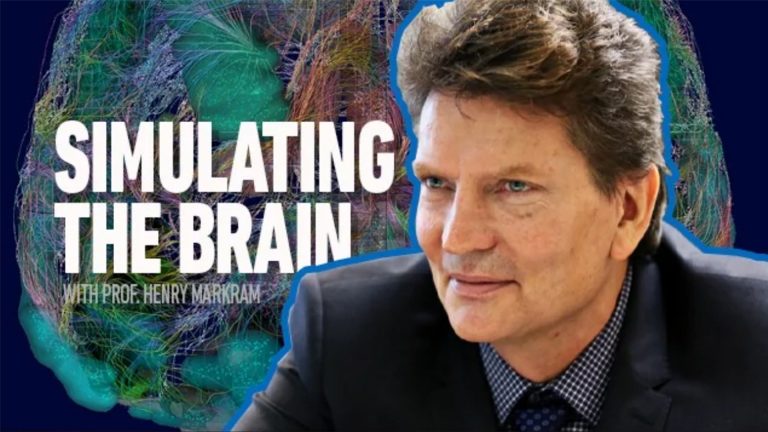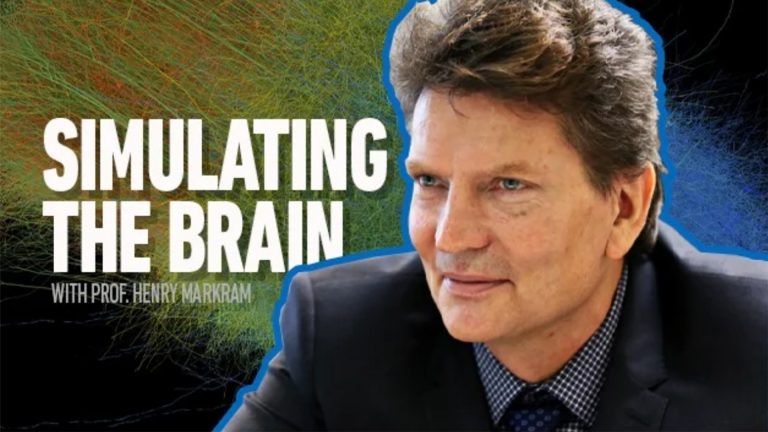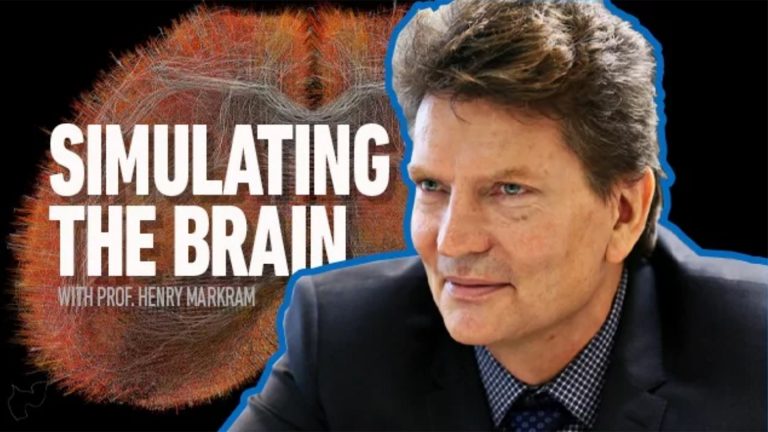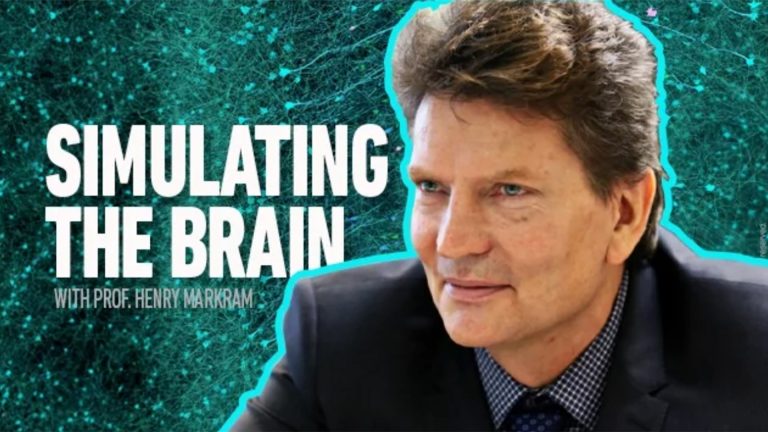Henry Markram

Henry Markram is a professor of neuroscience at the Swiss Federal Institute for Technology (EPFL), director of the Laboratory of Neural Microcircuitry (LNMC) and the Founder and Director of the Blue Brain Project.
After earning his PhD at the Weizmann Institute of Science, with distinction, he was a Fulbright scholar at the National Institutes of Health, and a Minerva Fellow at the Max-Planck Institute for Medical Research. In 1995, he returned to the Weizmann Institute, becoming an Associate Professor in 2000. In 2002, he became a full professor at EPFL.
Markram’s research has focused on synaptic plasticity and the microcircuitry of the neocortex, in which he has discovered fundamental principles governing synaptic plasticity and the structural and functional organization of neural microcircuitry. Other key discoveries include the concept of Liquid Computing and the Intense World Theory of Autism.
In 2005, he launched the Blue Brain Project to digitally reconstruct and simulate the mouse brain.
Markram has published well over three hundred papers which have been cited over 40’000 times. Since 2002, he has spearheaded Switzerland’s ambition to become a world leader in high performance computing and to prioritize simulation-based research; these fields are now two of the three national research priorities declared by the Swiss government.
Markram is also the founder of the Brain Mind Institute and the founder of the European Human Brain Project, one of two ten-year one billion Euro Flagship Projects selected in January 2013 by the European Commission. He designed and co-founded the Frontiers open access publishing model to bring efficiency, accountability and transparency to peer-review (frontiersin.org).
Markram has received numerous awards including the Shannon Visionary Award from Bell Labs and the International Hebb Award from the International Neural Network Society.
Henry has five kids and what he likes most is to go hiking with them in the Alps.
Selected Publications
Courcol, J.-D., Invernizzi, C. F., Landry, Z. C., Minisini, M., Baumgartner, D. A., Bonhoeffer, S., Chabriw, B., Clerc, E. E., Daniels, M., Getta, P., Girod, M., Kazala, K., Markram, H., Pasqualini, A., Martínez-Pérez, C., Peaudecerf, F. J., Peaudecerf, M. S., Pfreundt, U., Roller, B. R. K., Słomka, J., Vasse, M., Wheeler, J.D., Metzger, C.M.J.A., Stocker, R., and Schürmann, F. (2021). ARC: An open web-platform for request/supply matching for a prioritized and controlled COVID-19 response. Frontiers in Public Health, 9, 71. https://doi.org/10.3389/fpubh.2021.607677
Zisis, E., Keller, D., Kanari, L., Arnaudon, A., Gevaert, M., Delemontex, T., Coste, B., Foni, A., Abdellah, M., Calì, C., Hess, K., Magistretti, P. J., Schürmann, F., & Markram, H. (2021). Architecture of the neuro-glia-vascular system. bioRxiv, 2021.01.19. https://doi.org/10.1101/2021.01.19.427241
Kanari, L., Dictus, H., Chalimourda, A., Van Geit, W., Coste, B., Shillcock, J., Hess, K., & Markram, H. (2020).Computational synthesis of cortical dendritic morphologies. bioRxiv, 2020.04.17. https://doi.org/10.1101/2020.04.15.040410.
Abdellah, M., Guerrero, N. R., Lapere, S., Coggan, J. S., Keller, D., Coste, B., Dagar, S., Courcol, J.-D., Markram, H., & Schürmann, F. (2020). Interactive visualization and analysis of morphological skeletons of brain vasculature networks with VessMorphoVis. Bioinformatics, Oxford University Press. Vol. 36 (Supplement_1), i534–i541. https://doi.org/10.1093/bioinformatics/btaa461.
Damart, T., Van Geit, W., & Markram, H. (2020). Data driven building of realistic neuron model using IBEA and CMA evolution strategies. GECCO ’20 Proceedings of the 2020 Genetic and Evolutionary Computation Conference Companion, 35–36. https://doi.org/10.1145/3377929.3398161
Gal, E., Perin, R., Markram, H., London, M., & Segev, I. (2020). Neuron geometry underlies universal network features in cortical microcircuits.bioRxiv, 2020.05.07.
DOI: https://doi.org/10.1101/656058
Chindemi, G., Abdellah, M., Amsalem, O., Benavides-Piccione, R., Delattre, V., Doron, M., Ecker, A., King, J., Kumbhar, P., Monney, C., Perin, R., Rössert, C., Van Geit, W., DeFelipe, J., Graupner, M., Segev, I., Markram, H., & Muller, E. (2020). A calcium-based plasticity model predicts long-term potentiation and depression in the neocortex. bioRxiv, 2020.04.19. https://doi.org/10.1101/2020.04.19.043117
Coggan, J.S., Keller, D., Markram, H., Schürmann, F., and Magistretti, P.J. (2020). Excitation states of metabolic networks predict dose-response fingerprinting and ligand pulse phase signalling. Journal of Theoretical Biology, 487, 110123.
DOI: 10.1016/j.jtbi.2019.110123.
Nolte, M., Gal, E., Markram, H., and Reimann, M.W. (2020). Impact of higher-order network structure on emergent cortical activity. Network Neuroscience. 4(1), 292–314.
DOI: 10.1162/netn_a_00124.
Newton, T., Abdellah, M., Chevtchenko, G., Muller, E., Markram, H. Voltage-Sensitive Dye Imaging reveals inhibitory modulation of ongoing cortical activity (October 2019)
DOI: 10.1101/812008
Barros-Zulaica, N., Rahmon, J., Chindemi, G., Perin, R., Markram, H., Ramaswamy, S., and Muller, E. Estimating the readily-releasable vesicle pool size at layer 5 pyramidal connections in the neocortex. Front. Synaptic Neurosci., 15 October 2019.
DOI: 10.3389/fnsyn.2019.00029
Keller, D., Meystre, J., Veettil, R.V., Burri, O., Guiet, R., Schürmann, F., and Markram, H. (2019). A derived positional mapping of inhibitory subtypes in the somatosensory cortex. Front. Neuroanat. 13, 78.
DOI: 10.3389/fnana.2019.00078
Reimann, M.W., Gevaert, M., Shi, Y., Lu, H., Markram, H., and Muller, E. A null model of the mouse whole-neocortex micro-connectome. Nature Communications 29 August 2019.
DOI: 10.1038/s41467-019-11630-x
Casalegno, F., Newton, T., Daher, R., Abdelaziz, M., Lodi-Rizzini, A., Schürmann, F., Krejci, I., and Markram, H. (2019). Caries Detection with Near-Infrared Transillumination Using Deep Learning. Journal of Dental Research. Online 26 August 2019.
DOI: 10.1177/0022034519871884.
Nolte M., Reimann M.W., King J., Markram H., Muller E., Cortical reliability amid noise and chaos Nature Communications, 22 August 2019,
DOI: 10.1038/s41467-019-11633-8
Ranjan R, Logette E, Marani M, Herzog M, Tâche V, Scantamburlo E, Buchillier V and Markram H. A Kinetic Map of the Homomeric Voltage-Gated Potassium Channel (Kv) Family. Front. Cell. Neurosci., 20 August 2019. DOI: 10.3389/fncel.2019.00358
Iavarone E., Yi J., Shi Y., Zandt B.J., O’Reilly C., Van Geit W., Rössert C., Markram, H., Hill, S.L. (2019) Experimentally-constrained biophysical models of tonic and burst firing modes in thalamocortical neurons. PLOS Computational Biology 15(5): 1-23. e1006753.
DOI:10.1371/journal.pcbi.1006753
Fan X and Markram H (2019). A Brief History of Simulation Neuroscience. Front. Neuroinform. 13:32.07 May 2019-
DOI: 10.3389/fninf.2019.00032
Colangelo, C., Shichkova, P., Keller, D., Markram, H., and Ramaswamy, S. (2019). Cellular, Synaptic and Network Effects of Acetylcholine in the Neocortex. Frontiers in Neural Circuits 13, 24.
DOI: 10.3389/fncir.2019.00024
Kanari, L., Ramaswamy, S., Shi, Y., Morand, S., Meystre, Julie., Perin, R., Abdellah, M., Wang, Y., Hess, K., Markram., Objective Morphological Classification of Neocortical Pyramidal Cells. Cerebral Cortex, Volume 29, Issue 4, April 2019, Pages 1719–1735,
DOI: 10.1093/cercor/bhy339
Abdellah, M., Hernando, J., Eilemann, S., Lapere, S., Antille, N., Markram, H., and Schürmann, F. (2018). NeuroMorphoVis: a collaborative framework for analysis and visualization of neuronal morphology skeletons reconstructed from microscopy stacks. Bioinformatics 34, i574–i582.
DOI: 10.1093/bioinformatics/bty231.
Coggan, J.S., Calì, C., Keller, D., Agus, M., Boges, D., Abdellah, M., Kare, K., Lehväslaiho, H., Eilemann, S., Jolivet, R.B., Hadwiger, M., Markram, H., Schürmann, F., Magistretti, P.J. (2018a). A Process for Digitizing and Simulating Biologically Realistic Oligocellular Networks Demonstrated for the Neuro-Glio-Vascular Ensemble. Frontiers in Neuroscience 12, 664.
DOI: 10.3389/fnins.2018.00664.
Coggan, J.S., Keller, D., Calì, C., Lehväslaiho, H., Markram, H., Schürmann, F., and Magistretti, P.J. (2018b). Norepinephrine stimulates glycogenolysis in astrocytes to fuel neurons with lactate. PLOS Computational Biology 14(8).
DOI: 10.1371/journal.pcbi.1006392.
Erö, C., Gewaltig, M.-O., Keller, D., and Markram, H. (2018). A Cell Atlas for the Mouse Brain. Frontiers in Neuroinformatics 12, 84.
DOI: 10.3389/fninf.2018.00084
Kanari, L., Dłotko, P., Scolamiero, M., Levi, R., Shillcock, J., Hess, K., and Markram, H. (2018a). A Topological Representation of Branching Neuronal Morphologies. Neuroinformatics 16, 3–13.
https://link.springer.com/article/10.1007%2Fs12021-017-9341-1.
Keller, D., Erö, C., and Markram, H. (2018). Cell Densities in the Mouse Brain: A Systematic Review. Front. Neuroanat. 12, 83.
DOI: 10.3389/fnana.2018.00083.
Migliore, R., Lupascu, C.A., Bologna, L.L., Romani, A., Courcol, J.-D., Antonel, S., Van Geit, W.A.H., Thomson, A.M., Mercer, A., Lange, S., Falck, J., Roessert, C. A., Freund, T. F., Kali, S., Muller, E. B., Schürmann, F., Markram, H., Migliore, M. (2018). The physiological variability of channel density in hippocampal CA1 pyramidal cells and interneurons explored using a unified data-driven modeling workflow. PLOS Computational Biology 14(9).
DOI: 10.1371/journal.pcbi.1006423.
Ramaswamy, S., Colangelo, C., and Markram, H. (2018). Data-Driven Modeling of Cholinergic Modulation of Neural Microcircuits: Bridging Neurons, Synapses and Network Activity. Front. Neural Circuits 12, 77–77.
https://www.frontiersin.org/articles/10.3389/fncir.2018.00077/full
Ramaswamy, S., Muller, E., Reimann, M., and Markram, H. (2018). Microcircuitry of the neocortex. In Handbook of Brain Microcircuits, Section 1: Neocortex, Chapter 3, G.M. Shepherd, and S. Grillner, eds. (Oxford University Press), p. 35-46.
https://books.google.ch/books?id=n8M9DwAAQBAJ.
Abdellah, M., Bilgili, A., Eilemann, S., Markram, H., and Schürmann, F. (2017). A Physically Plausible Model for Rendering Highly Scattering Fluorescent Participating Media. arXiv, v2, 12 June 2017.
https://arxiv.org/abs/1706.03024v2.
Abdellah, M., Bilgili, A., Eilemann, S., Shillcock, J., Markram, H., and Schürmann, F. (2017). Bio-physically plausible visualization of highly scattering fluorescent neocortical models for in silico experimentation. BMC Bioinformatics 18, 62.
DOI: 10.1186/s12859-016-1444-4
Abdellah, M., Hernando, J., Antille, N., Eilemann, S., Markram, H., and Schürmann, F. (2017). Reconstruction and visualization of large-scale volumetric models of neocorticalcircuits for physically-plausible in silico optical studies. BMC Bioinformatics 18, 402.
DOI: 10.1186/s12859-017-1788-4
Doron, M., Chindemi, G., Muller, E., Markram, H., and Segev, I. (2017). Timed SynapticInhibition Shapes NMDA Spikes, Influencing Local Dendritic Processing and Global I/OProperties of Cortical Neurons. Cell Rep 21, 1550–1561.
DOI: 10.1016/j.celrep.2017.10.035
Gal, E., London, M., Globerson, A., Ramaswamy, S., Reimann, M.W., Muller, E., Markram, H., and Segev, I. (2017). Rich cell-type-specific network topology in neocortical microcircuitry. Nat. Neurosci. 20, 1004–1013.
DOI: 10.1038/nn.4576
Reimann, M.W., Horlemann, A.-L., Ramaswamy, S., Muller, E.B., and Markram, H. (2017). Morphological Diversity Strongly Constrains Synaptic Connectivity and Plasticity. Cereb.Cortex 27, 4570–4585.
DOI: 10.1093/cercor/bhx150
Reimann, M.W., Nolte, M., Scolamiero, M., Turner, K., Perin, R., Chindemi, G., Dłotko, P., Levi, R., Hess, K., and Markram, H. (2017). Cliques of Neurons Bound into Cavities Provide a Missing Link between Structure and Function. Front Comput Neurosci 11, 48.
DOI: 10.3389/fncom.2017.00048
Amsalem, O., Van Geit, W., Muller, E., Markram, H., and Segev, I. (2016). From Neuron Biophysics to Orientation Selectivity in Electrically Coupled Networks of Neocortical L2/3 Large Basket Cells. Cereb. Cortex 26, 3655–3668. DOI: 10.1093/cercor/bhw166
Kanari, L., Dlotko, P., Scolamiero, M., Levi, R., Shillcock, J., Hess, K., and Markram, H. (2016). Quantifying topological invariants of neuronal morphologies. arXiv. arXiv:1603.08432v1
Van Geit, W., Gevaert, M., Chindemi, G., Rössert, C., Courcol, J.-D., Muller, E.B., Schürmann, F., Segev, I., and Markram, H. (2016). BluePyOpt: Leveraging Open Source Software and Cloud Infrastructure to Optimise Model Parameters in Neuroscience. Front Neuroinform 10.
DOI: 10.3389/fninf.2016.00017
Monica Regina, F., La Mendola, D., Meystre, J., Christodoulou, D., Cochrane, M. et al. (2015). Curing the negative symptoms in autism: Predictable Enriched Environment Prevents Development of Hyper-Emotionality in the VPA Rat Model of Autism. Frontiers in Neuroscience, 9(127). DOI: 10.3389/fnins.2015.00127
H. Markram, E. Muller, S. Ramaswamy, Michael W. Reimann, M. Abdellah, Carlos A. Sanchez, A. Ailamaki, L. Alonso-Nanclares, N. Antille, S. Arsever, Guy Antoine A. Kahou, Thomas K. Berger, A. Bilgili, N. Buncic, A. Chalimourda, G. Chindemi, J.-D. Courcol, F. Delalondre, V. Delattre, S. Druckmann, R. Dumusc, J. Dynes, S. Eilemann, E. Gal, Michael E. Gevaert, J.-P. Ghobril, A. Gidon, Joe W. Graham, A. Gupta, V. Haenel, E. Hay, T. Heinis, Juan B. Hernando, M. Hines, L. Kanari, D. Keller, J. Kenyon, G. Khazen, Y. Kim, James G. King, Z. Kisvarday, P. Kumbhar, S. Lasserre, J.-V. Le Bé, Bruno R.C. Magalhães, A. Merchán-Pérez, J. Meystre, Benjamin R. Morrice, J. Muller, A. Muñoz-Céspedes, S. Muralidhar, K. Muthurasa, D. Nachbaur, Taylor H. Newton, M. Nolte, A. Ovcharenko, J. Palacios, L. Pastor, R. Perin, R. Ranjan, I. Riachi, J.-R. Rodríguez, Juan L. Riquelme, C. Rössert, K. Sfyrakis, Y. Shi, Julian C. Shillcock, G. Silberberg, R. Silva, F. Tauheed, M. Telefont, M. Toledo-Rodriguez, T. Tränkler, W. Van Geit, Jafet V. Díaz, R. Walker, Y. Wang, Stefano M. Zaninetta, J. DeFelipe, Sean L. Hill, I. Segev, and F. Schürmann, Reconstruction and Simulation of Neocortical Microcircuitry. Cell 163, 2015, 456-492.
DOI: 10.1016/j.cell.2015.09.029
S. Ramaswamy, J.-D. Courcol, M. Abdellah, S.R. Adaszewski, N. Antille, S. Arsever, G. Atenekeng, A. Bilgili, Y. Brukau, A. Chalimourda, G. Chindemi, F. Delalondre, R. Dumusc, S. Eilemann, M.E. Gevaert, P. Gleeson, J.W. Graham, J.B. Hernando, L. Kanari, Y. Katkov, D. Keller, J.G. King, R. Ranjan, M.W. Reimann, C. Rössert, Y. Shi, J.C. Shillcock, M. Telefont, W. Van Geit, J. Villafranca Diaz, R. Walker, Y. Wang, S.M. Zaninetta, J. DeFelipe, S.L. Hill, J. Muller, I. Segev, F. Schürmann, E.B. Muller, and H. Markram, The neocortical microcircuit collaboration portal: a resource for rat somatosensory cortex. Front. Neural Circuits, 2015, 44.
DOI: 10.3389/fncir.2015.00044
M. Reimann, E.Muller, S.Ramaswamy, H.Markram: An Algorithm to Predict the Connectome of Neural Microcircuits. 2015. Frontiers in Neural Circuits 9 2015, 28.
DOI: 10.3389/fncom.2015.00120
M.Abdellah, A.Bilgilli, S.Eilemann, H.Markram, F.Schürmann : Physically-based in silico light sheet microscopy for visualizing fluorescent brain models. BMC Bioinformatics. 2015 Aug 13;16 Suppl 11:S8
DOI: 10.1186/1471-2105-16-S11-S8
V.Delattre, D.Keller, M.Perich, H.Markram, E.B.Muller: Network-timing-dependent plasticity. Front Cell Neurosci. 2015 Ju 9;9:220.
DOI: 10.3389/fncel.2015.00220
Anastassiou CA, Perin R, Buzsáki G, Markram H, Koch C. Cell type- and activity-dependent extracellular correlates of intracellular spiking. J Neurophysiol. 2015 Jul;114(1):608-23. doi: 10.1152/jn.00628.2014.
DOI: 10.1152/jn.00628.2014
S.Ramaswamy, H.Markram: Anatomy and Physiology of the thick-tufted layer 5 pyramidal neuron, Front Cell Neurosci. 2015; 9:233.
DOI: 10.3389/fncel.2015.00233
D.Keller, N.Babai, O.Kochubey, Y.Han, H.Markram, F.Schürmann, R.Schneggenburger: An Exclusion Zone for Ca2+ Channels around Docked Vesicles Explains Release Control by Multiple Channels at a CNS Synapse, PLoS Comput Biol. 2015 May 7;11(5):e1004253.
DOI: 10.1371/journal.pcbi.1004253
Costantini I, Ghobril JP, Di Giovanna AP, Allegra Mascaro AL, Silvestri L, Müllenbroich MC, Onofri L, Conti V, Vanzi F, Sacconi L, Guerrini R, Markram H, Iannello G, Pavone FS A versatile clearing agent for multi-modal brain imaging. Scientific Reports. 2015 May 7;5:9808.
DOI: 10.1038/srep09808.
Frackowiak R, Markram H. The future of human cerebral cartography: a novel approach. Philos Trans R Soc Lond B Biol Sci. 2015 May 19;370(1668). pii: 20140171.
DOI: 10.1098/rstb.2014.0171.
S.Muralidhar, Y.Wang, H.Markram: Synaptic and cellular organization of layer 1 of the developing rat somatosensory cortex. Front Neuroanat. 2014 Jan 16;7:52. DOI: 10.3389/fnana.2013.00052
F.Tauheed, T.Heinis, F.Schürmann, H.Markram, A.Ailamaki : OCTOPUS: Efficient Query Execution on Dynamic Mesh Datasets, In Proceedings of the 30th IEEE International Conference on Data Engineering. Chicago, USA, March 2014. DOI: 10.1109/ICDE.2014.6816718
J.DeFelipe, E.Garrido, H.Markram: The death of Cajal and the end of scientific romanticism and individualism. Trends Neurosci. 37(10):525-7 (2014). DOI: 10.1016/j.tins.2014.08.002
Toledo-Rodriguez, M., and Markram, H. (2014). New Edition: Single-cell RT-PCR, a technique to decipher the electrical, anatomical, and genetic determinants of neuronal diversity. In: Martina M., Taverna S. (eds)Patch-Clamp Methods and Protocols. Methods in Molecular Biology (Methods and Protocols). In Methods in Molecular Biology, pp. 143–158. [For accessible earlier version see Toledo-Rodriquez et al 2007.]
DOI: 10.1007/978-1-4939-1096-0_8
M.W. Reimann, C.A.Anastassiou, R.Perin, S.L.Hill, H. Markram, C. Koch: A biophysically detailed model of neocortical local field potentials predicts the critical role of active membrane currents. Neuron, 79(2), 375-390, 2013. DOI: 0.1016/j.neuron.2013.05.023
E. Hay, F. Schürmann, H. Markram, I. Segev: Preserving axosomatic spiking features despite diverse dendritic morphology. J Neurophysiol, 109(12), 2972-2981, 2013. DOI: 10.1152/jn.00048.2013
R.Perin, M.Telefont, H.Markram: Computing the size and number of neuronal clusters in local circuits, Front Neuroanat. 2013;7:1. Epub 2013 Feb 19. DOI: 10.3389/fnana.2013.00001
A.Loebel, JV.LeBe, MJ.Richardson, H.Markram, A.Herz: Matched pre- and post-synaptic changes underlie synaptic plasticity over long time scales. 2013. J Neurosci. 33(15):6257-66.
DOI: 10.1523/JNEUROSCI.3740-12.2013
H.Markram: Seven challenges for Neuroscience. 2013. Functional Neurology. 28(3):145-51. DOI: 10.11138/FNeur/2013.28.3.145
ER.Kandel, H.Markram, PM.Matthews, R.Yuste, C.Koch: Neuroscience thinks big (and collaboratively). 2013. Nat Rev Neurosci. 14(9):659-64.
DOI: 10.1038/nrn3578
J.DeFelipe et al. [42 authors]: New insights into the classification and nomenclature of cortical GABAergic interneurons. 2013. Nat Rev Neurosci. 14(3):202-16.
DOI: 10.1038/nrn3444
S.Druckmann, S.Hill, F.Schürmann, H.Markram, I.Segev : A Hierarchical Structure of Cortical Interneuron Electrical Diversity Revealed by Automated Statistical Analysis, Cerebral Cortex, (2012), doi: 10.1093/cercor/bhs290.
DOI: 10.1093/cercor/bhs290
Markram, H., Gerstner, W., and Sjöström, P.J. (2012). Editorial Article: Spike-timing-dependent plasticity: a comprehensive overview. Front Synaptic Neurosci 4, 2.
DOI: 10.3389/fnsyn.2012.00002
Tauheed, F., Biveinis, L., Heinis, T., Schurmann, F., Markram, H., and Ailamaki, A. (2012a). Accelerating Range Queries for Brain Simulations. In Proceedings of the 2012 IEEE 28th International Conference on Data Engineering, (Washington, DC, USA: IEEE Computer Society), pp. 941–952.
DOI: 10.1109/ICDE.2012.56
S.L.Hill, Y.Wang, I.Riachi, F.Schürmann, H.Markram: Statistical connectivity provides a sufficient foundation for specific functional connectivity in neocortical neural microcircuits, PNAS, Published online before print September 18, 2012.
DOI: 10.1073/pnas.1202128109
F.Tauheed, T.Heinis, F.Schürmann, H.Markram, A.Ailamaki: SCOUT: Prefetching of Latent Structure Following Queries, VLDB 2012.
DOI: 10.14778/2350229.2350267
G.Khazen, S.L.Hill, F.Schürmann , and H.Markram: Combinatorial Expression Rules of Ion Channel Genes in Juvenile Rat (Rattus norvegicus) Neocortical Neurons, PLoS One, 7(4): e34786.
DOI: 10.1371/journal.pone.0034786
S.Lasserre, J.Hernando, S.Hill, F.Schürmann, P. de Miguel Anasagasti, G.Abou Jaoudé, H.Markram : A Neuron Mesh Representation for Visualization of Electrophysiological Simulations, IEEE Transactions on Visualization and Computer Graphics, 18 (2): p. 214-217.
DOI: 10.1109/TVCG.2011.55
Ramaswamy, S., Hill, S. L., King, J. G., Markram, H., Schürmann, F., Wang, Y., et al. Power of being different: Intrinsic Morphological Diversity of Thick-Tufted Layer 5 Pyramidal Neurons Ensures Robust and Invariant Properties of In Silico Synaptic Connections. J Physiol, 590, pp. 737-52. DOI: 10.1113/jphysiol.2011.219576
S.Ramaswamy, S.L.Hill, J.G.King, F.Schürmann, Y.Wang, and H.Markram: Intrinsic Morphological Diversity of Thick-tufted Layer 5 Pyramidal Neurons Ensures Robust and Invariant Properties of in silico Synaptic Connections. J Physiol. 2012 Feb 15;590(Pt 4):737-52. Epub 2011 Nov 14.
DOI: 10.1113/jphysiol.2011.219576
R.Ranjan, G.Khazen, L.Gambazzi, S.Ramaswamy, S.L.Hill, F.Schürmann, and H.Markram: Channelpedia: an integrative and interactive database for ion channels, Front. Neuroinform 2011. 5:36.
DOI: 10.3389/fninf.2011.00036
E.Hay, S.L.Hill, F.Schürmann, H.Markram, and I.Segev: Models of Neocortical Layer 5b Pyramidal Cells Capturing a Wide Range of Dendritic and Perisomatic Active Properties. PLoS Computational Biology 2011, 7(7): e1002107.
DOI: 10.1371/journal.pcbi.1002107
S.Druckmann, T.K.Berger, F.Schürmann, S.L.Hill, H.Markram, and I.Segev: Effective stimuli for constructing reliable neuron models, Plos Computational Biology, 2011, 7(8): e1002133.
DOI: 10.1371/journal.pcbi.1002133
R.Perin, T.K.Berger, and H.Markram: A synaptic organizing principle for cortical neuronal groups, PNAS, 2011, 108 (12).
DOI: 10.1073/pnas.1016051108
S.Romand, Y.Wang, M.Toledo-Rodriguez, and H.Markram: Morphological development of thick-tufted layer v pyramidal cells in the rat somatosensory cortex, Front Neuroanat. 2011 5:5.
DOI: 10.3389/fnana.2011.00005
CA.Anastassiou, R.Perin, H.Markram, and C.Koch: Ephaptic coupling of cortical neurons, Nat Neurosci. 2011 Feb;14(2):217-23.
DOI: 10.1038/nn.2727
H. Markram, W. Gerstner, PJ. Sjöström: A history of spike-timing-dependent plasticity. Front Synaptic Neurosci. 2011;3:4. Epub 2011 Aug 29.
DOI: 10.3389/fnsyn.2011.00004
H. Markram, R. Perin: Innate neural assemblies for lego memory. Front Neural Circuits. 2011;5:6. Epub 2011 May 16.
DOI: 10.3389/fncir.2011.00006
Markram, K., and Markram, H., (2010). Just too intense: The Intense World Theory – a Unifying Theory of the Neurobiology of Autism. Frontiers in Human Neuroscience, 4, pp. 224. DOI: 10.3389/fnhum.2010.00224
TK.Berger, G.Silberberg, R.Perin, and H.Markram: Brief bursts self-inhibit and correlate the pyramidal network, PLoS Biol. 2010 Sep 7;8(9).
DOI: 10.1371/journal.pbio.1000473
Silva, T., Le Bé, J. -V., Riachi, I., Rinaldi, T., Markram, K., Markram, M, (2009). Super circuit learning in autism: Enhanced Long-Term Microcircuit Plasticity in the Valproic Acid Animal Model of Autism. Frontiers in Synaptic Neuroscience, 1, pp. 1. DOI: 10.3389/neuro.19.001.2009
A.Loebel, G.Silberberg, D.Helbig, H.Markram, M.Tsodyks, MJ.Richardson: Multiquantal release underlies the distribution of synaptic efficacies in the neocortex, Front Comput Neurosci. 2009; 3:27.
DOI: 10.3389/neuro.10.027.2009
TK.Berger, R.Perin, G.Silberberg, and H.Markram: Frequency-dependent disynaptic inhibition in the pyramidal network: a ubiquitous pathway in the developing rat neocortex, J Physiol. 2009 Nov 15;587(Pt 22):5411-25.
DOI: 10.1113/jphysiol.2009.176552
J.G.King, M.Hines, S.Hill, P.H.Goodman, H.Markram, F.Schürmann: A component-based extension framework for large-scale parallel simulations in NEURON , Front Neuroinformatics, 3:10.
DOI: 10.3389/neuro.11.010.2009
Anwar H., Riachi I., Schürmann F., Markram H. (2009). “An approach to capturing neuron morphological diversity,” in Computational Neuroscience: Realistic Modeling for Experimentalistsed. De Schutter E., editor. (Cambridge: The MIT Press) 211–232. https://mitpress.mit.edu/books/computational-modeling-methods-neuroscientists.
ISBN 978-0-262-01327
Markram, K., Rinaldi, T., La Mendola, D., Sandi, C., and Markram, H., (2008). Super fear in autism: Abnormal Fear Conditioning and Amygdala Processing in an Animal Model of Autism. Neuropsychopharmacology, 33(4), pp. 901-12. DOI: 10.1038/sj.npp.1301453
J.Kozloski, K.Sfyrakis, S.Hill, F.Schürmann, C.Peck, H.Markram: Identifying, tabulating, and analyzing contacts between branched neuron morphologies, IBM Journal of Research and Development, Vol 52, Number 1/2, 2008.
ISSN:0018-8646
M.Hines, H.Markram, F.Schürmann: Fully Implicit Parallel Simulation of Single Neurons, J. Comput. Neurosci., 25(3):439-48, 2008.
DOI: 10.1007/s10827-008-0087-5
S.Druckmann, T.Berger, S.Hill, F.Schürmann, H.Markram, I.Segev: Evaluating automated parameter constraining procedures of neuron models by experimental and surrogate data, Biol Cybern, 99(4-5):371-9, 2008.
DOI: 10.1007/s00422-008-0269-2
O.Melamed, O.Barak, G.Silberberg, H.Markram, M.Tsodyks: Slow oscillations in neural networks with facilitating synapses, J Comput Neurosci. 2008 Oct;25(2):308-16.
DOI: 10.1007/s10827-008-0080-z
GA.Ascoli, Alonso-Nanclares L, Anderson SA, Barrionuevo G, Benavides-Piccione R, Burkhalter A, Buzsáki G, Cauli B, Defelipe J, Fairén A, Feldmeyer D, Fishell G, Fregnac Y, Freund TF, Gardner D, Gardner EP, Goldberg JH, Helmstaedter M, Hestrin S, Karube F, Kisvárday ZF, Lambolez B, Lewis DA, Marin O, Markram H, Muñoz A, Packer A, Petersen CC, Rockland KS, Rossier J, Rudy B, Somogyi P, Staiger JF, Tamas G, Thomson AM, Toledo-Rodriguez M, Wang Y, West DC, Yuste R.: Petilla terminology: nomenclature of features of GABAergic interneurons of the cerebral cortex, Nat Rev Neurosci. 2008 Jul;9(7):557-68.
DOI: 10.1038/nrn2402
H.Markram: Fixing the location and dimensions of functional neocortical columns, HFSP J. 2008 Jun;2(3):132-5.
DOI: 10.2976/1.2919545
Rinaldi, T., Kulangara, K., Antoniello, K., Markram, H., (2007). Super synaptic learning in autism: Elevated NMDA Receptor Levels and Enhanced Postsynaptic Long-Term Potentiation Induced by Prenatal Exposure to Valproic Acid. PNAS, 104(33), pp. 13501-6. DOI: 10.1073/pnas.0704391104
Rinaldi, T., Kulangara, K., Antoniello, K., Markram, H., (2007). Super synaptic learning in autism: Elevated NMDA Receptor Levels and Enhanced Postsynaptic Long-Term Potentiation Induced by Prenatal Exposure to Valproic Acid. PNAS, 104(33), pp. 13501-6. DOI: 10.1073/pnas.0704391104
Rinaldi, T., Silberberg, G., and Markram, H., (2008). Hyperconnectivity of Local Neocortical Microcircuitry Induced by Prenatal Exposure to Valproic Acid. Cereb Cortex, 18(4), pp. 763-70. DOI: 10.1093/cercor/bhm117
C.Calì, TK.Berger, M.Pignatelli, A.Carleton, H.Markram, M.Giugliano: Inferring connection proximity in networks of electrically coupled cells by subthreshold frequency response analysis, J Comput Neurosci. 2008 Jun;24(3):330-45. Epub 2007 Nov 28.
DOI: 10.1007/s10827-007-0058-2
G.Silberberg and H.Markram: Disynaptic inhibition between neocortical pyramidal cells mediated by Martinotti cells, Neuron. 2007 Mar 1;53(5):735-46.
DOI: 10.1016/j.neuron.2007.02.012
H.Markram: Bioinformatics: industrializing neuroscience. Nature. 2007 Jan 11;445(7124):160-1.
DOI: 10.1038/445160a
S.Druckmann, Y.Banitt, A.Gidon, F.Schürmann, H.Markram, and I.Segev: A Novel Multiple Objective Optimization Framework for Constraining Conductance-Based Neuron Models by Experimental Data, Frontiers in Neuroscience, Vol. 1, Issue 1, 2007.
DOI: 10.3389/neuro.01.1.1.001.2007
M.Toledo-Rodriguez and H.Markram: Single-cell RT-PCR, a technique to decipher the electrical, anatomical, and genetic determinants of neuronal diversity, Methods Mol Biol. 2007;403:123-39.
DOI: 10.1007/978-1-59745-529-9_8
JV.Le Bé, G.Silberberg, Y.Wang, and H.Markram: Morphological, electrophysiological, and synaptic properties of corticocallosal pyramidal cells in the neonatal rat neocortex, Cereb Cortex. 2007 Sep;17(9):2204-13.
DOI: 10.1093/cercor/bhl127
M.Migliore, C.Cannia, W.W.Lytton, H.Markram, and M.L.Hines: Parallel network simulations with NEURON, J Comput Neurosci. 2006 Oct;21(2):119-29.
DOI: 10.1007/s10827-006-7949-5
H.Markram: The blue brain project. Nat Rev Neurosci. 7, 153-160, 2006.
DOI: 10.1038/nrn1848
Y.Wang, H.Markram, PH.Goodman, TK.Berger , J.Ma PS.Goldman-Rakic: Heterogeneity in the pyramidal network of the medial prefrontal cortex, Nat Neurosci. 2006 Apr;9(4):534-42.
DOI: 10.1038/nn1670
JV.Le Bé and H.Markram: Spontaneous and evoked synaptic rewiring in the neonatal neocortex, PNAS. 2006 Aug 29;103(35):13214-9.
DOI: 10.1073/pnas.0604691103
A.J. Muhammad, H. Markram, NEOBASE: Databasing the Neocortical Microcircuit, Stud Health Technol Inform. 2005;112:167-77.
Maass, W., Natschläger, T., and Markram, H., (2002). The brain as a super liquid: Real-Time Computing Without Stable States: A New Framework for Neural Computation Based on Perturbations. Neural Computation, 14(11), pp. 2531-2560. DOI: 10.1162/089976602760407955
Markram, H., Helm, P. J., and Sakmann, B., (1995). A “loud” dendritic calcium signal: Dendritic Calcium Transients Evoked by Single Back-Propagating Action Potentials in Rat Neocortical Pyramidal Neurons. J Physiol, 485, pp. 1-20. DOI: 10.1113/jphysiol.1995.sp020708
Markram, H., and Sakmann, B., (1994). A “soft: dendritic calcium signal: Calcium Transients in Apical Dendrites Evoked by Single Sub-Threshold Excitatory Post-Synaptic Potentials via Low Voltage-Activated Calcium Channels. PNAS, 91, pp. 5207-5211. DOI: 10.1073/pnas.91.11.5207



